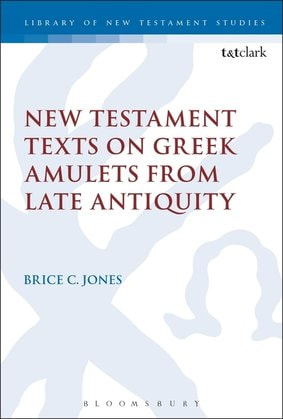|
My article on a recently identified papyrus has finally been published in the latest issue of the Journal of Biblical Literature (JBL). The small scrap of papyrus, housed in the University of Michigan Papyrology Collection, contains a partial citation of Matthew 1:20 in Greek. I argue that the papyrus may have served as an amulet, as this passage from the gospel of Matthew is ritually charged (it involves the utterance of an angel), is written on one side, and appears to have been folded. I have tentatively dated the papyrus to the sixth-seventh century C.E. Despite its fairly late date, it is the only amulet to preserve this portion of gospel text and stands among the earliest textual evidence for this particular verse.
Since my book on Greek New Testament amulets was published in 2016, two other amulets have been published, excluding this one: Thomas Wayment published a Greek papyrus amulet containing a citation from Colossians, and Lincoln Blummel published one with a citation from Acts. I recommend that all three of these should be added to the list of amulets that started with Ernst von Dobschütz in 1923, a category that I have argued should be reinstated in the official list of New Testament manuscript, overseen by the Institut for Neutestamentliche Textforschung. I have uploaded the article to the publications section of this website here. UPDATE: This fragment has been assigned a number in the Trismegistos/LDAB portal as 754090 and can now be cited accordingly.
3 Comments
tony prost
3/28/2018 02:02:37 pm
congratulations!
Reply
Roy Kotansky
3/29/2018 04:39:50 pm
Beautiful work, Brice, but I would assign this to a typical 3rd cent. CE hand. It certainly doesn't look as old as the 6th/7th century, palaeographically. Is that because you judge it to be an amulet and therefore "late"? And is the fold what I think I see through the upper K, downwards? Also, do you read KAT' O[NAR]? If an O that "omicron" is pretty darn cursive, isn't it? (Because it looks like a (pointed) N that follows).
Reply
3/29/2018 11:32:44 pm
Thanks, Roy, and good to hear from you. I’m fairly sure about the 6th-7th dating, although these are always best judgments. I don’t, however, see this belonging to the 3rd century at all. The scribe wrote KAT’ ANAR—final alpha of KATA was elided and then there was a misspelling of ONAR. The publication can be found in the “Publications” tab of this website where you can find further details.
Reply
Your comment will be posted after it is approved.
Leave a Reply. |

Available at Amazon!
Archives
June 2020
Categories
All
|
